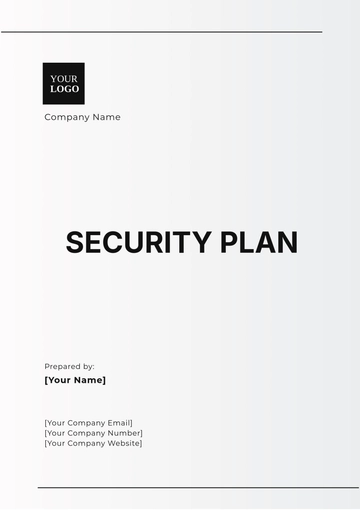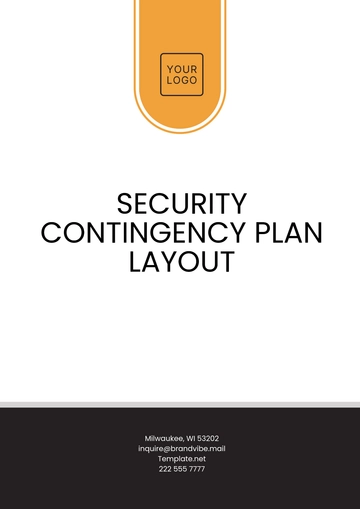Free Home Security Plan for Rental

I. Introduction
Ensuring the safety and security of your rental home is a top priority, especially when you have limited control over certain aspects of the property. Renters may not be able to make structural changes like homeowners, but there are many practical and effective steps that can be taken to strengthen security measures. A well-thought-out security plan not only safeguards your personal belongings but also enhances your overall peace of mind in a rented space.
II. Assessment of Current Security
Conducting a thorough assessment of your rental property's existing security features is the foundation of any effective security strategy. This step helps identify potential vulnerabilities and areas for improvement.
A. Property Inspection
Check for existing security systems: Review if the property already has an alarm system or surveillance cameras. Ensure they are functional and up-to-date.
Inspect all entry points: examine doors, windows, and any accessible points such as balconies or basements for potential weak spots.
Evaluate the lighting around the property: Ensure there is adequate lighting at all entrances, walkways, and dark corners, especially at night, to deter intruders.
B. Neighborhood Analysis
Research local crime rates: Use crime-tracking websites or contact local law enforcement to get a sense of the safety levels in the neighborhood.
Identify nearby security services or police stations: Know the proximity of emergency services and ensure you’re aware of local response times in case of a break-in or emergency.
III. Security Enhancements
Once the initial assessment is complete, consider security upgrades that align with your rental agreement and comply with any legal limitations. These can greatly reduce the likelihood of unauthorized entry or theft.
Entry Points
Install deadbolts or upgrade existing locks: Secure your doors with high-quality deadbolts. Where possible, consider additional security like chain locks or door reinforcement plates.
Use window locks or reinforcements: Install secondary locks or security bars for windows, especially ground-floor or accessible windows, to prevent easy break-ins.
B. Surveillance Options
Wireless security camera system: Many wireless cameras are renter-friendly, as they require minimal installation and can be easily removed. Consider options that offer mobile alerts and remote monitoring.
Smart doorbells with video capability: Video doorbells provide real-time alerts when someone approaches your front door, offering added peace of mind when you're not home.
Lighting Improvements
Install motion sensor lights: Motion-activated lights around entrances and dark areas of the property can deter potential intruders.
Ensure all entry points are well-lit: Make sure the property’s exterior, particularly entry points, remains well-illuminated throughout the night to discourage suspicious activity.
IV. Behavioral Practices
In addition to physical enhancements, adopting careful security practices in your daily routine can further reduce the risk of theft or unauthorized access.
A. Routine Checks
Regularly check locks and alarms: Ensure that door and window locks, as well as alarm systems, are functioning correctly. Regular maintenance prevents malfunctions when security is most needed.
Secure windows when leaving the house: Even if you are stepping out briefly, always ensure windows are closed and locked.
B. Safety Habits
Keep valuable items out of sight: Don’t leave valuable items, such as electronics or jewelry, in plain view from windows. Use curtains or blinds to obscure the inside of your home.
Avoid sharing travel plans on social media: Publicly announcing that you will be away on vacation can invite potential burglars. Share such details with trusted friends or family privately.
V. Emergency Preparedness
Being well-prepared for emergencies is crucial for responding quickly and effectively to potential security threats. A solid emergency plan can make a significant difference in how you handle a crisis.
A. Emergency Contacts
Maintain a list of emergency numbers: Keep a printed list of important contact numbers, including local authorities, property management, and nearby security services. Store these in easily accessible locations.
Inform trusted neighbors: Let reliable neighbors know when you'll be away for an extended period, and ask them to keep an eye on your property.
B. Evacuation Plan
Develop a clear evacuation plan: Create an emergency escape plan for all residents, identifying the safest routes to exit the property in case of fire, intruder alerts, or natural disasters.
Conduct regular drills. Practice your evacuation plan to ensure all residents know how to respond quickly and safely during an emergency.
VI. Conclusion
By taking a proactive approach to rental security, you can significantly enhance the safety and protection of your home, even if it’s a temporary living arrangement. From conducting a thorough assessment to implementing security upgrades and fostering responsible habits, these steps will help create a secure living environment. Building a customized security plan tailored to your rental property’s specific needs is not only crucial for safeguarding your belongings but also essential for ensuring peace of mind.
- 100% Customizable, free editor
- Access 1 Million+ Templates, photo’s & graphics
- Download or share as a template
- Click and replace photos, graphics, text, backgrounds
- Resize, crop, AI write & more
- Access advanced editor
Enhance your property protection with the Home Security Plan for Rental Template, designed to meet your unique needs. This customizable and downloadable template provides a comprehensive framework for outlining security measures, ensuring your rental property remains safe. It's easily printable and editable in our AI Editor Tool, allowing you to personalize it effortlessly. Secure your peace of mind today with this essential resource, offered by Template.net.
You may also like
- Finance Plan
- Construction Plan
- Sales Plan
- Development Plan
- Career Plan
- Budget Plan
- HR Plan
- Education Plan
- Transition Plan
- Work Plan
- Training Plan
- Communication Plan
- Operation Plan
- Health And Safety Plan
- Strategy Plan
- Professional Development Plan
- Advertising Plan
- Risk Management Plan
- Restaurant Plan
- School Plan
- Nursing Home Patient Care Plan
- Nursing Care Plan
- Plan Event
- Startup Plan
- Social Media Plan
- Staffing Plan
- Annual Plan
- Content Plan
- Payment Plan
- Implementation Plan
- Hotel Plan
- Workout Plan
- Accounting Plan
- Campaign Plan
- Essay Plan
- 30 60 90 Day Plan
- Research Plan
- Recruitment Plan
- 90 Day Plan
- Quarterly Plan
- Emergency Plan
- 5 Year Plan
- Gym Plan
- Personal Plan
- IT and Software Plan
- Treatment Plan
- Real Estate Plan
- Law Firm Plan
- Healthcare Plan
- Improvement Plan
- Media Plan
- 5 Year Business Plan
- Learning Plan
- Marketing Campaign Plan
- Travel Agency Plan
- Cleaning Services Plan
- Interior Design Plan
- Performance Plan
- PR Plan
- Birth Plan
- Life Plan
- SEO Plan
- Disaster Recovery Plan
- Continuity Plan
- Launch Plan
- Legal Plan
- Behavior Plan
- Performance Improvement Plan
- Salon Plan
- Security Plan
- Security Management Plan
- Employee Development Plan
- Quality Plan
- Service Improvement Plan
- Growth Plan
- Incident Response Plan
- Basketball Plan
- Emergency Action Plan
- Product Launch Plan
- Spa Plan
- Employee Training Plan
- Data Analysis Plan
- Employee Action Plan
- Territory Plan
- Audit Plan
- Classroom Plan
- Activity Plan
- Parenting Plan
- Care Plan
- Project Execution Plan
- Exercise Plan
- Internship Plan
- Software Development Plan
- Continuous Improvement Plan
- Leave Plan
- 90 Day Sales Plan
- Advertising Agency Plan
- Employee Transition Plan
- Smart Action Plan
- Workplace Safety Plan
- Behavior Change Plan
- Contingency Plan
- Continuity of Operations Plan
- Health Plan
- Quality Control Plan
- Self Plan
- Sports Development Plan
- Change Management Plan
- Ecommerce Plan
- Personal Financial Plan
- Process Improvement Plan
- 30-60-90 Day Sales Plan
- Crisis Management Plan
- Engagement Plan
- Execution Plan
- Pandemic Plan
- Quality Assurance Plan
- Service Continuity Plan
- Agile Project Plan
- Fundraising Plan
- Job Transition Plan
- Asset Maintenance Plan
- Maintenance Plan
- Software Test Plan
- Staff Training and Development Plan
- 3 Year Plan
- Brand Activation Plan
- Release Plan
- Resource Plan
- Risk Mitigation Plan
- Teacher Plan
- 30 60 90 Day Plan for New Manager
- Food Safety Plan
- Food Truck Plan
- Hiring Plan
- Quality Management Plan
- Wellness Plan
- Behavior Intervention Plan
- Bonus Plan
- Investment Plan
- Maternity Leave Plan
- Pandemic Response Plan
- Succession Planning
- Coaching Plan
- Configuration Management Plan
- Remote Work Plan
- Self Care Plan
- Teaching Plan
- 100-Day Plan
- HACCP Plan
- Student Plan
- Sustainability Plan
- 30 60 90 Day Plan for Interview
- Access Plan
- Site Specific Safety Plan





























